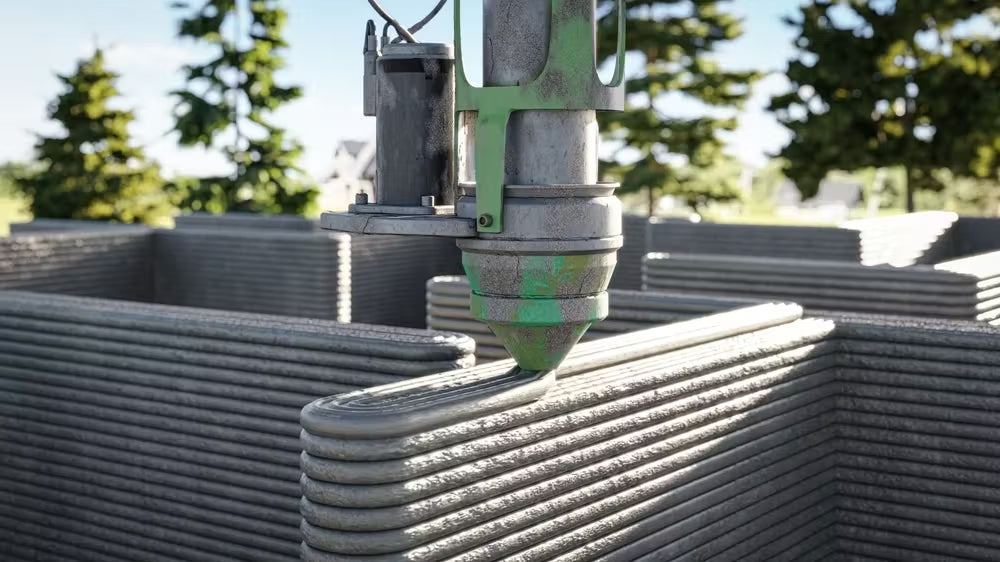
The Future of 3D Printing in Construction: Innovation, Challenges and Opportunities
Share
3D printing is revolutionising the construction industry, enabling the creation of faster, more sustainable and more cost-effective structures. It addresses the current impact of the technology, the challenges it faces and the opportunities it presents, and highlights recent and innovative examples that show how your company can benefit from this evolution.

The Current Impact of 3D Printing on Construction
Sustainable Construction
One of the biggest advantages of 3D printing in construction is its ability to reduce material waste. Unlike traditional methods, where excess material often becomes waste, 3D printing uses exactly the amount of material needed, minimizing environmental impact.
Furthermore, this technology allows for the use of eco-friendly materials, such as recycled concrete or bioplastics, further contributing to sustainability. Some projects are already taking advantage of these materials, such as the construction of 3D-printed eco-homes that use local soil combined with sustainable polymers.
Acceleration of the Construction Process
Automation in 3D printing has enabled a significant acceleration in construction times. While traditional methods can take months, even years, to complete a structure, 3D printing can reduce this time to weeks or days.
A prominent example is the 24-hour printed homes project, where large-scale 3D printers are used to build entire homes in a single day. This not only saves time, but also reduces labor costs and delivery time, making it an attractive option for developers and builders.
Challenges and Limitations
Technological Restrictions
Despite its advances, 3D printing in construction faces several technological limitations. Currently, most 3D printers used in construction have restrictions on the size of the structures they can create and the materials they can use.
Furthermore, while 3D printed structures are innovative, there are still challenges in terms of durability and strength, especially in extreme environments. The industry is working to overcome these obstacles by developing new techniques and materials that improve structural strength without sacrificing design flexibility.

Regulatory and Normative Obstacles
Another significant challenge is the lack of regulations and standards specific to 3D printing construction. Most current regulations are designed for traditional construction methods, which can create barriers to mass adoption of the technology.
For example, in some countries, building codes do not recognize 3D printed structures, making their approval and certification difficult. However, efforts are being made internationally to develop standards that can facilitate the integration of this technology into the construction market.
Future Opportunities
Expansion to New Materials and Methods
The future of 3D printing in construction is full of possibilities, especially when it comes to expanding materials and methods. Currently, research is focused on developing new materials, such as advanced composites and recycled materials, that can offer improved structural properties and sustainability.
In addition, new printing techniques are being explored, such as hybrid printing, which combines multiple materials into a single structure. These innovations will not only make it possible to create stronger and more durable buildings, but also more complex and customized structures.
Personalization and Complex Architecture
3D printing’s ability to create custom designs and complex structures is one of its greatest strengths. Unlike traditional methods, which can be limited by available tools and molds, 3D printing allows architects and designers to experiment with shapes and configurations that were previously unthinkable.
This not only has the potential to revolutionize modern architecture, but also to transform urban design, allowing the creation of buildings that are better adapted to their surroundings and the specific needs of their users.
Featured Case Studies
Pioneering Projects in 3D Printing
One of the most notable case studies is that of the 24-hour printed houses . This project has shown that it is possible to build safe and affordable housing in record time using 3D printing. These houses, made of printed concrete, are not only quick to build, but also durable and energy efficient.
Another example is the 3D printed concrete bridge in the Netherlands, which has demonstrated that 3D printing can be used for larger and more complex infrastructures. This project is a milestone in civil engineering and offers a glimpse into the future of 3D printed infrastructures.
Innovations in Emerging Countries
3D printing is also being used to address the housing crisis in low-income regions. In emerging countries, where demand for affordable housing outstrips supply, 3D printing offers a fast and inexpensive solution.
There are exciting 3D printing projects underway in emerging countries . For example, in Latin America and Africa, they are using this technology to build entire communities of affordable housing in a matter of weeks. These innovations are not only providing homes to those who need them most, but are also demonstrating the transformative power of technology in challenging contexts.
Conclusion
3D printing is ushering in a new era in construction, with significant advantages in terms of sustainability, efficiency and customization. As the technology continues to evolve, the possibilities for its application in construction are virtually limitless. Your company has the opportunity to be at the forefront of this revolution, embracing these innovations to transform the way projects are designed and built.

We understand that every project is unique, so we work closely with our clients to understand their specific needs and deliver tailored solutions to suit their goals and budgets.
Our expertise in a variety of 3D printing technologies allows us to offer a wide range of materials and finishes to meet the most demanding requirements. In addition, our focus on efficiency and design optimization allows us to offer fast delivery times without compromising quality.
At Printatonic, we are committed to providing exceptional service and outstanding results on every project. Trust us to bring your ideas from concept to reality with our cutting-edge 3D printing expertise and unmatched attention to detail.
Contact us today to find out how we can help you make your vision a reality.

